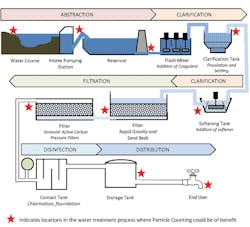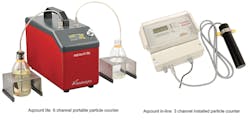Counting on Quality
Particle counters in the field provide an invaluable tool for the analysis of the cleanliness of a sample
For many years, the water industry has used turbidity meters to monitor the quality of drinking water. Though initially concerned with the aesthetic — clear and odorless water is important to the customer — the industry soon found other applications, such as measuring contamination from suspended solids and colorizing chemicals. Turbidity meters also fulfil a role in process control such as increasing efficiency of filter systems. Subsequent development of these instruments has extended their sensitivity to measure changes not easily discernible by the naked eye. Engineering of filters and detectors to ‘tune into' specific wavelengths could extend their use even further.
Particle counting adds benefits throughout the water treatment and distribution process.
Turbidity is by definition an ensemble test. Turbidity gives a measure of the whole body of the sample, it measures the complex interaction of light on multiple suspended particles of varying size, shape, color and reflectivity. Though turbidity measurement still reigns supreme in measurement of the perceived quality, it is the ability of the particle counter to quantify both size and number that makes it a more analytical, and therefore useful, tool.
Particle counting technology accuracy has improved, and laser and processing technologies have allowed for real-time measurement of multiple size bands. Particle counters now range from laboratory-based analytical instruments to battery-powered portable units for field use, from simple self-contained in-line installations with display to continuous monitoring with 4-20 mA outputs, high/low count alarms and relay switching functions.
AvCount particle counters from Seta Analytics are available as both bench-top and portable models.
Their extended sensitivity and ability to classify particles into sizes means that applications for particle counting in the potable water industry are wide ranging, extending far beyond a basic measurement of the plant influent and effluent. Particle counters in the field provide an invaluable tool for the analysis of the cleanliness of a sample; investigating seasonal changes in suspended solids due to rainfall; dust and grit contamination from quarrying and mining processes, and others.
In the plant, either as portable or installed systems, they can be used to monitor filter efficiency, for predictive maintenance by indicating the need for back-flushing or for detecting the onset of failure of membrane filters. Particle counting can give an insight into the control of coagulation and flocculation processes, helping to determine the optimum quantity of coagulant to be added to the raw water and the most efficient sedimentation time.
Light extinction (laser obscuration) particle counters, like AvCount from Seta Analytics, are capable of measuring down to the 3 μm region. They are sufficiently sensitive to give a surrogate indication of the presence of microorganisms by measuring and counting cysts and oocysts from microbial contaminants such as Cryptosporidium (4 to 6 μm), Cyclospora (8 to 10 μm) and Giardia (8 to 12 μm).
Seta Analytics (a division of Stanhope-Seta) produces a number of particle counters suitable for use in the water industry, including laboratory, in-line and portable versions. Learn more at www.stanhope-seta.co.uk/AvCount_Particle_Counting.asp.
Circle No. 226 on Reader Service Card


